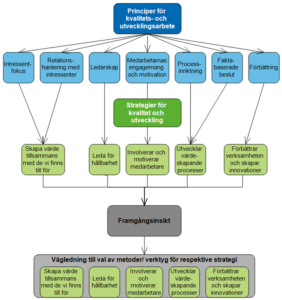When I took on my current assignment as a management and governance strategist with a focus on quality and operational development at the overall level, the work was very much about addressing urgent needs, which the operations raised as important to take care of at the overall level.
These included management systems, management of governing documents, internal control with a focus on quality risks, process-oriented working methods, deviation management and management processes. So a lot about different ways of working!
About forty different tools useful in organizations' systematic improvement work, such as 5P, 5 Why, A3 template, Fishbone diagram, Force field analysis, Impact analysis, etc. were already in place thanks to talented business developers in the organizations. We could undoubtedly note the "check" on the quality structure!
What we, at the organization-wide level, could not note "check" on was a structured approach to developing the quality culture. However, it should be added that several activities in the organization had or were developing a strong quality culture, often due to the fact that they had started working in accordance with ISO 9001 Quality Management System.
What we, in the overall quality and development council, did to create a basis for the work on quality culture was to decide on a policy for quality and development work. The policy presents definitions of quality and development and seven basic principles for quality and development work based on SS-EN ISO 9000:2015 "Quality management systems - Principles and terminology". This was a natural step, as the principles of stakeholder focus, stakeholder relationship management, leadership, employee engagement and motivation, process orientation, improvement and evidence-based decision-making harmonized with our overall quality management system.
But we knew very well that with only a number of guiding principles there would not be much action. So the next step was to attach a number of strategies based on SIQ success factors. The main reason for calling them strategies instead of success factors was that strategies were part of the nomenclature used in the organization's business planning. Bringing in quality and development, based on SIQ success factors, as a strategy to achieve the organization's objectives for citizens and society is in itself a success factor. It has also provided us with a vision for future quality work based on societal benefit, sustainable development and stakeholder satisfaction, which in itself is in line with the organization's mission.
It was then natural to link the measurement of quality culture using SIQ Success Insight and SIQ Quality Culture Index for dialogue and prioritization, but also to link the results from these to appropriate tools in order to, if necessary, be able to work further on priority actions.
As an answer to my own question in the title, it has been both a prerequisite and a success factor for us as an organization to create a "wonderful mix" of ISO standards and SIQ Success factors, based on our own needs. A current example is that SIQ Success factors are a natural part when we work with standards linked to Effective management team work.


Michael Sjöberg, PhD in ecology and environmental management
Strategist in management and governance, Chairman of Region Örebro County's quality and development council, National preparatory group for standardization within regions.
